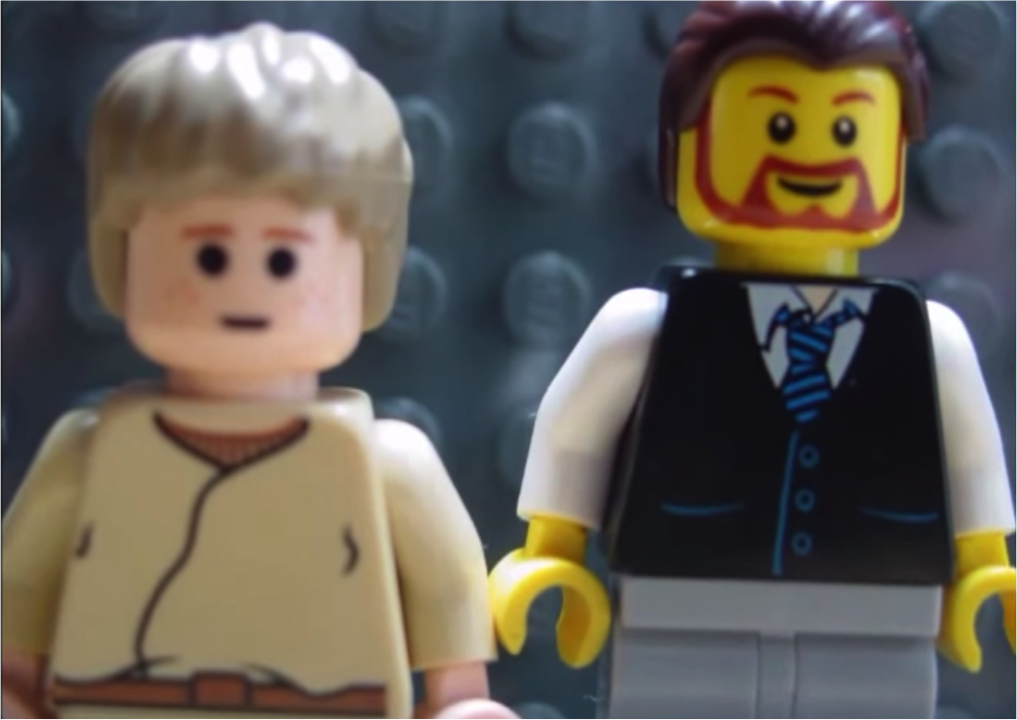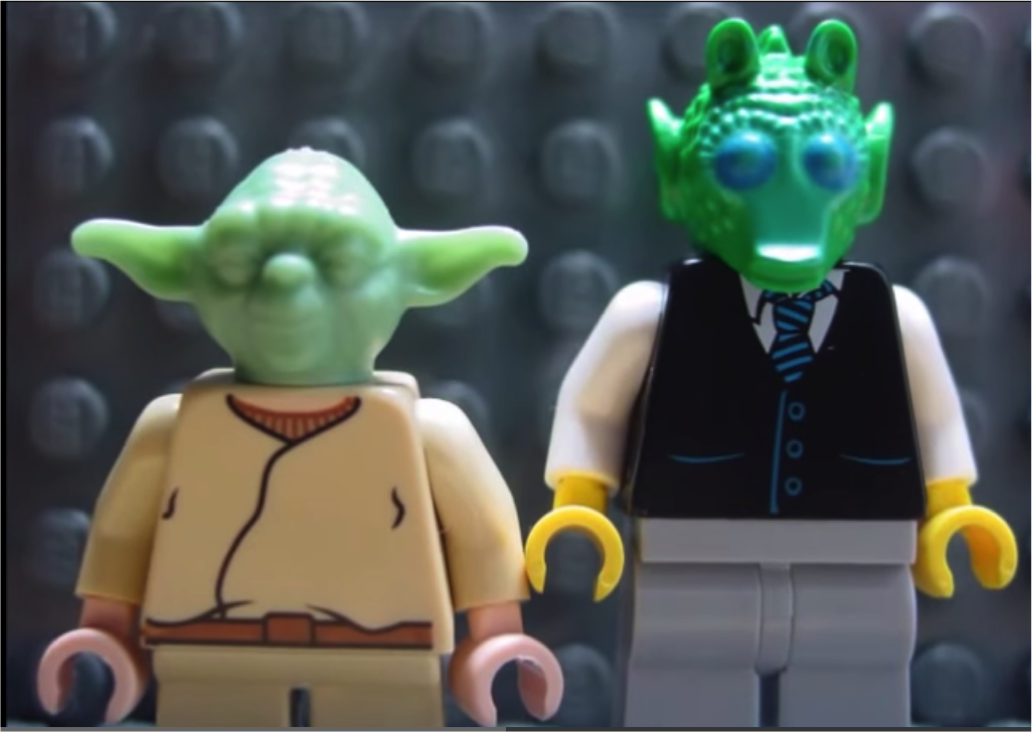New Ethical Questions and Social Media: Young People’s Construction of Holocaust Memory Online
Originally published in Frames Cinema Journal
Introduction
Much of the discourse about the ethics of Holocaust representation considers it a sacred event that imposes representational limits. Survivors are often considered “authorities” of Holocaust memory. However, Alasdair Richardson defines the Holocaust as an event “on the edge of living memory”: soon there will be no first-hand witnesses to share their stories.[1] When the last survivor dies, the responsibility to remember will be entirely passed onto a new generation who cannot provide first-hand accounts of events; they did not literally witness this tragic past, but are called to “bear witness” in a more abstract sense as they remember the Holocaust through memorials, education and other media.[2] While debates about the “appropriateness” of Holocaust representation have long-existed, the recent surge in online engagement with it complicates issues further and has led to the International Holocaust Remembrance Alliance (IHRA) launching social media guidelines for educators.[3]
Young people are particularly prevalent users of social media, thus it is not surprising that they might turn to this format to remember the Holocaust. The theme of this issue is conflicting images/ contested realities, and much of the youth-produced material relating to the Holocaust online has been contested by the press and academics because it appears to conflict with pre-existing guidelines about the ethics of Holocaust representation by not presenting the truthful and solemn engagement expected of such works. Should this be particularly concerning? This paper considers the extent to which pre-existing guidelines about “appropriate” representation, mostly defined by survivors, are still relevant to young producers of digital Holocaust memory, and whether there might be new ethical questions that are as, if not more, important. Is the fact these contested images conflict with pre-existing ethical guidelines problematic or productive?
Holocaust Memory, Representation and Digital Media
When Anna Reading suggested in 2001 that “the Holocaust has taken on a virtual dimension”, she could hardly have predicted the impact digital technology would have on contemporary Holocaust memory.[4] There is now an abundance of digital material available or in development, from hologram survivors to digital archives; virtual ghetto tours to Holocaust denial YouTube “documentaries”.[5]The democracy of the Internet offers users a variety of different explorations of this past and gives opportunities for a wide range of individuals to participate in producing Holocaust memory, as well as consuming it. While professional organisations will be more aware of the guidelines associated with “approriate” Holocaust representation (whether they adhere to or deliberately challenge them), it is less likely that the average Internet user will have this knowledge, especially young people.
There is a growing number of platforms, in relation to material constructed for users, that enables anyone to contribute to Holocaust memory, including YouTube, Twitter and Facebook. The YouTube video I Will Survive Auschwitz shows a male survivor with his grandchildren dancing at various concentration camps.[6] It received mixed feedback, with many survivors lambasting it as distasteful, but younger generations celebrating it as the survivor’s way of remembering his history.[7] The site also hosts numerous youth-produced Lego stop-motion videos about the Holocaust that have also faced criticism for impropriety. However, if the new generation is to be the future authority of Holocaust memory, then to completely condemn its modes of communication is counter-productive. Behind the drive to remember are imperatives to learn from the past and defend against denial. By refusing to engage with young people’s preferred methods of communication, we risk discouraging them from engaging with Holocaust memory.
Criticism about Holocaust representation is often influenced by survivors Terrence Des Pres and Elie Wiesel’s writings. Des Pres commands that the Holocaust must be represented accurately and treated as a solemn and unique event.[8] While Wiesel condemns that mainstream media, particularly NBC’s Holocaust miniseries (Marvin J. Chomsky, 1978), for “trivialising” the Holocaust.[9] Wiesel critiques the series’ use of melodrama and soap opera conventions which were unavoidable given its format. However, as Lawrence Baron notes, the formal limitations of film (and by extension, television) should not automatically mean that these media are not suitable for Holocaust representation, particularly when they have the potential to reach wide audiences.[10] In response to criticisms of Holocaust, Andreas Huyssen states:
If it is our concern and responsibility to prevent forgetting, we have to be open to the powerful effects that a melodramatic soap opera can exert on the minds of viewers today. The post-Holocaust generations that received their primary socialization through television may find their way toward testimony, documentary, and historical treaties precisely via a fictionalized and emotionalized Holocaust made for prime time television.[11]
Huyssen’s words should also be heeded in the context of social media, through which today’s young people receive “their primary socialization”.[12] On the Internet, they can quickly find their way to historical sources, literally a few “clicks” away from any initial encounter. However, social media is more complex than television because young people are no longer just spectators, but users and producers.[13]
Work by Meghan McGlinn Manfra and Jeremy D. Stoddard, Anna Reading and Peter A. Sproat focuses on web content about genocide created for young people rather than by them, thus does not fully account for the democratic possibilities and limitations of the Internet.[14] They highlight texts that enable young people to see and hear eyewitnesses, but engage them less in actively contributing to memory. In one of the few works about youth-produced content online, Jason Hansen notes “the development of new technologies […] [has] dramatically reduced the barriers to participation that have historically limited the influence of individuals in [the process of the construction of public memory]”. [15] Young people are now producing memory as well as consuming it.
In response to this new trend, in 2014, IHRA published guidelines for using social media in Holocaust education. The report recognises that with changing technologies, any definition of “social media” must be fluid, but recognises it as digital spaces that is “not passive”, where “individuals […] actively participate, collaborate, contribute, and create”.[16] The report highlights the misconception that young people are digital natives, the usefulness of moderation and privacy tools and the public nature of social media; it specifically emphasises the importance of appropriateness, vocabulary, and historical context when discussing the Holocaust online: issues at the forefront of wider debates about Holocaust representation.[17] While the report is targeted at educators, these issues are relevant to thinking about young people’s use of social media too.
I now turn to one example of youth-produced social media to examine the extent to which it speaks to pre-existing ethical frameworks about Holocaust representation and the new challenges its online dimension offers. I will discuss Circle Productions’“brickfilm” – a Lego stop-motion animation – Lego Holocaust (2011) uploaded to YouTube. The following analysis explores how this example of youth-produced social media engagement with Holocaust memory speaks to, and often transgresses, long-established concerns about the appropriateness, but also reveals new challenges social media introduce to discourses about Holocaust memory and representation.
Lego Holocaust
Two male Lego figures, one looking concerned, one more cheerful, appear on screen. A narrator explains that these are “normal looking people”, but that “Hitler and his followers saw them as powerful enemies”. There is a cut, and in the next shot the men’s heads have changed to monstrous faces – more specifically, Star Wars fans will recognise them as Yoda and Greedo (famous characters from the series). This is the opening sequence to Circle Productions’s “brickfilm” Lego Holocaust. The film continues with a Lego narrator stating that he will explain what happened during the Holocaust. This is followed by the film’s only non-Lego image: an archival photograph of a yellow star that is shown as the narrator explains, in voiceover, that some of the ways Jews were segregated in Nazi Germany. A series of historical re-enactments are then presented in Lego, with characters’ voices provided through voiceover. Firstly, an authoritative Lego figure orders a general to carry out mass executions. Then there is a confrontation between three male Lego figures in a shop, representing the boycotting of Jewish businesses. After this, an official unloads a Jewish man from a Lego police car into a concentration camp mostly constructed of grey Lego bricks. Here, the Jewish man witnesses a shooting, where plasticine is used to express the victims’ blood.
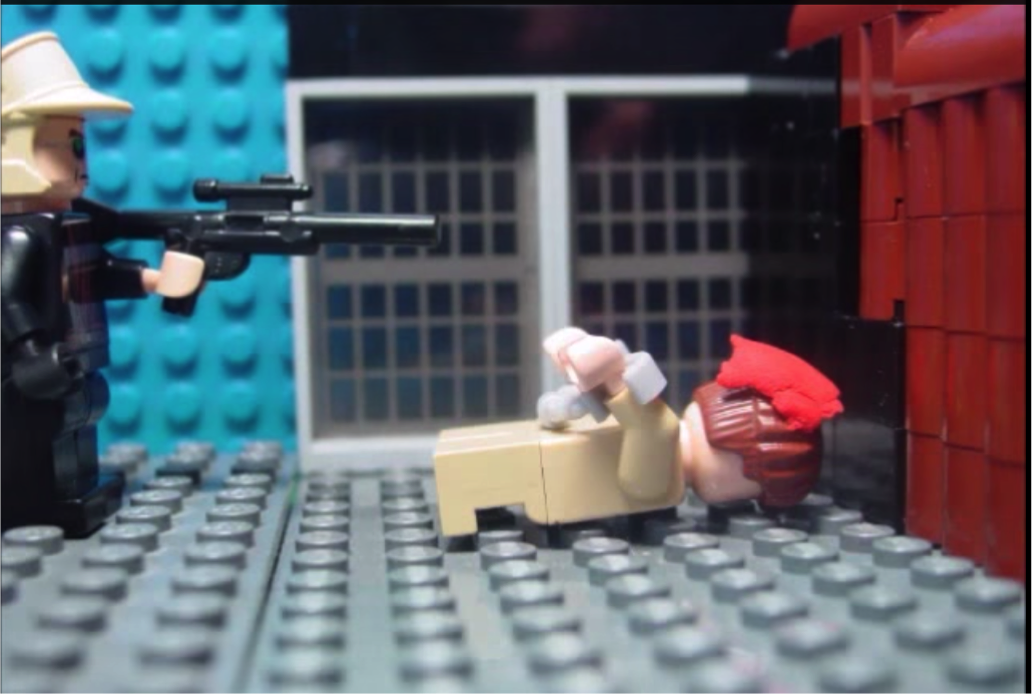
Then, the narrator stands in the barracks of the camp describing living conditions before a black screen is accompanied by different characters’ voices exclaiming their fear and asking “where is God?”. Finally skeleton Lego figures with yellow heads enter the gas chamber. They fall to the ground, before a transition shows the same characters now with skeleton heads to match their bodies.
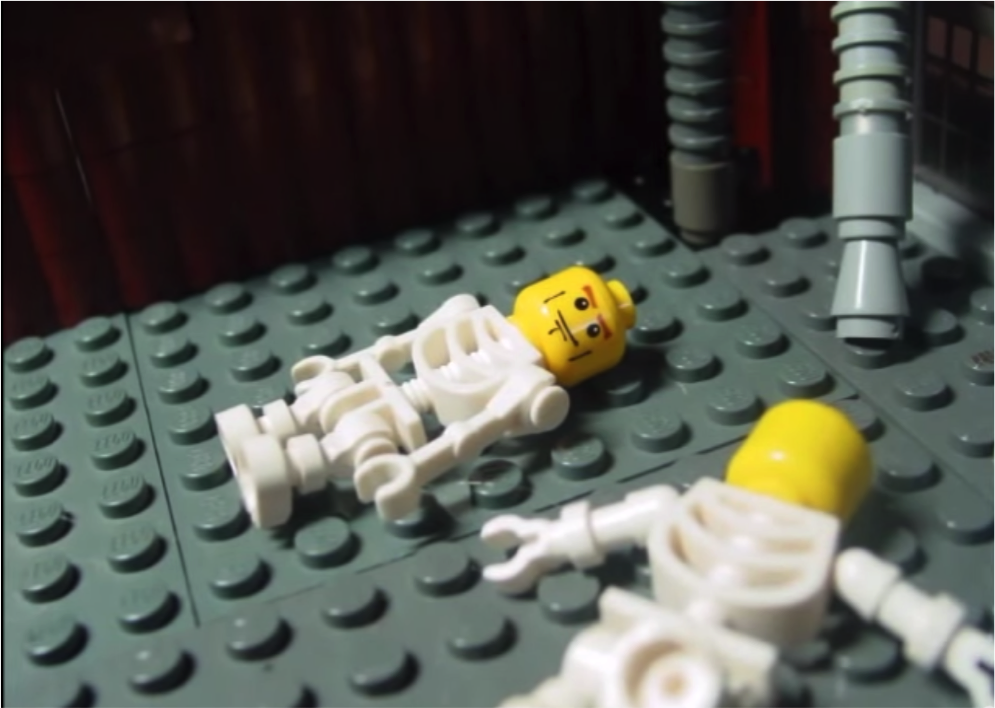
At first glance, the fact that Lego Holocaust is an animation might seem particularly problematic. Paul Wells and Alan Cholodenko relate animation to “bringing to life”, while the Holocaust was characterised by torture and mass murder.[18] However, the form has often been used to address serious issues in animated documentaries, a genre that one could consider to characterise Lego Holocaust. Annabelle Honess Roe defines such a film, as one that “(1) has been recorded or recreated frame by frame; (ii) is about the world rather than a world wholly imagined by its creators; and (iii) has been presented as a documentary by its producers and/or received as a documentary by audiences, festivals or critics”.[19] As a stop-motion film that attempts to tell the history of the Holocaust (however simply), Lego Holocaust clearly fulfills Honess Roe’s first two criteria. Though the filmhas not attracted enough public attention to fairly judge it against the third, its educational structure and use of documentary techniques such as an objective narrator, archival photograph and a narrative about the history of a real event, suggest Lego Holocaust is an animated documentary. The film’s producers have clearly attempted to “give a sense of what we understand reality itself to have been” (as Bill Nichols identifies as conventional of documentaries) by re-enacting scenarios related to the Holocaust, however this does not necessarily mean Lego Holocaust offers, what Wiesel and Des Pres would consider, an accurate, non-trivial representation.[20]
Circle Productions is a group of animators that produce “brickfilms”, mostly for school projects.[21] There is a growing number of such films online, the popularity of which has led to the development of www.Brickfilms.com and the Academy Award-winning feature film, The Lego Movie (Phil Lord & Christopher Miller, 2014). Many amateur works are uploaded to YouTube. Evidence in video descriptions suggests schools are adopting this as a form of creative independent learning. However, it is not necessarily teachers that suggest the use of Lego. When a commenter on YouTube asked Circle Productions if Lego Holocaust was created for homework, one of the film”s producers replied: “It was an RE portfolio and was better than writing about it [sic]”. This comment implies it was the young students who decided to use Lego for the assignment. Joshua Leasure of www.Brickfilms.com notes that while Lego is historically associated with play, when making such works “you stop seeing Legos as toys. You get used to seeing them moving around acting… from a film perspective, it becomes just another medium”. However, he identifies two major limitations of Brickfilms: the one facial expression of the characters, usually a grin, and the need to use voice to distinguish identities and emotion.[22] Interestingly Lego Holocaust’s first Jewish character looks concerned rather than smiley. As Baron highlights with live-action, “brickfilms’” limitations are part of their identity, when a Jewish man is transported to a concentration camp in a white police van in Lego Holocaust this foregrounds the imaginative compromises the producers have to make in order to compose their narrative with Lego. It is not necessarily an attempt to dishonour the memory of the Holocaust.
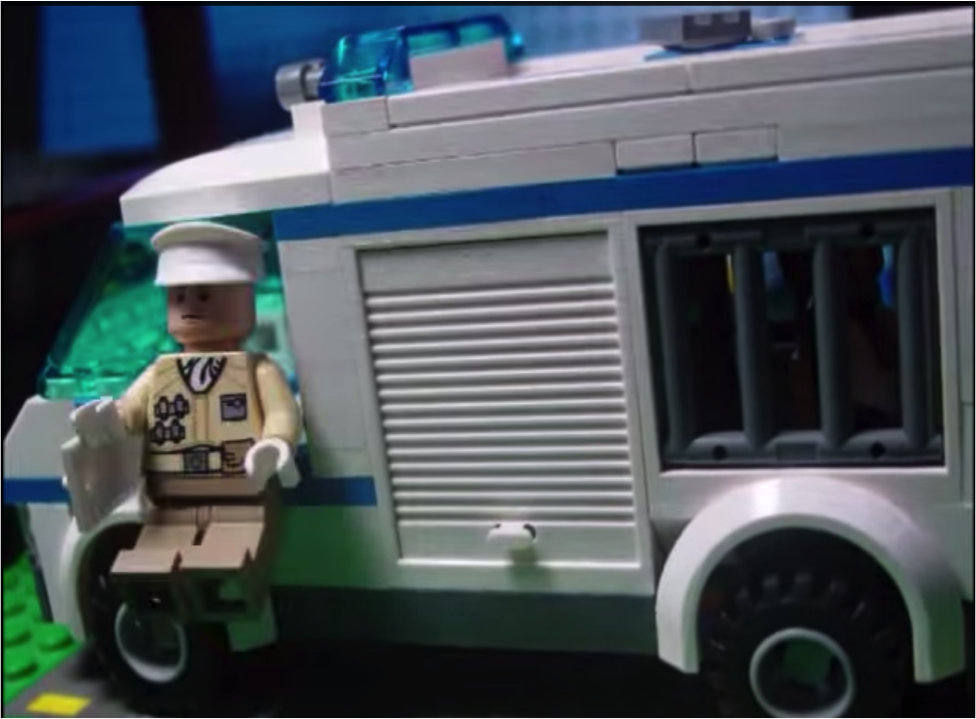
If Lego Holocaust is held up to pre-existing guidelines about Holocaust representation, then it seems “inappropriate”. While the young producers clearly attempt to educate their audience, they certainly do not engage with the factual complexity of the Holocaust. Furthermore, the use of colourful Lego pieces might be construed as refuting the solemness of the event. The mostly smiling characters and bright colours certainly evoke a sense of the trivial. When Hansen spoke to one of the young boys involved, the producer attempted to quantify his awareness and knowledge about the Holocaust stating that he “supplemented information he had gained from a Holocaust-related diary his class was reading with images of concentration camps from the H.B.O miniseries Band of Brothers and ‘information from my dad’”.[23] While his research sources may not be academic, as to be expected of a child, the film clearly reveals an attempt to tackle some sophisticated lines of thought. Lego Holocaust uses a “contemporary” Lego narrator who walks through “historical” spaces, such as the barracks, explaining the living conditions. Circle Productions seems to subtly engage with the differences between concentration camps then and now, emphasising that they are spaces one can walk through freely today.
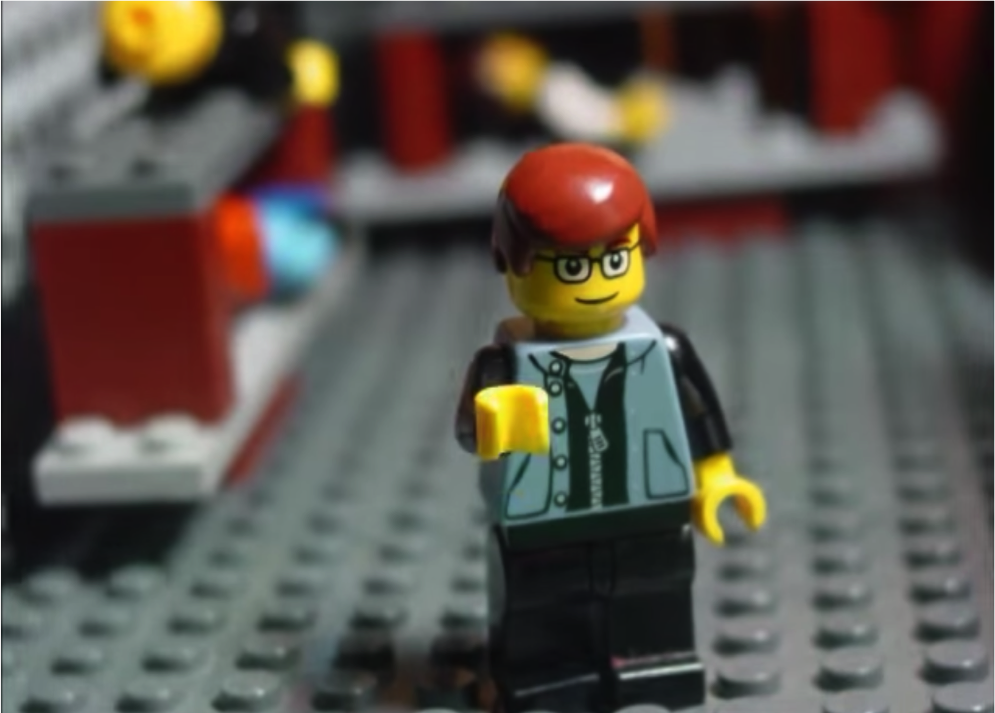
It is significant that the narrator does not enter the gas chamber, which can be read in the context of debates about la pellicule maudite (the “confounded” or “missing reel” – mythological footage of the gas chamber in action, the use of which was debated by Claude Lanzmann and Jean-Luc Godard. The former claimed such footage should be destroyed, while the latter, that it must be shown to redeem cinema of its failure to record the Holocaust. [24]). Furthermore, the choice not to place the narrator in the gas chamber emphasises this as a moment the spectator (and producers) can never truly understand even through mediated forms – no one can share the victims’ experiences. The producers use a mixed media approach, including a photograph of a yellow star emphasising the “reality” behind the re-creation, reminding the spectator that while this may look colourful and animated, it refers to a real, tragic era of history. A dark screen represents the barracks at night, as one of the prisoners asks “why have we been abandoned by God?”, while others express fear, highlighting a plurality of responses and referring, however simplistically, to the theological questions provoked by the Holocaust. However, the brief time the young producers give to each of these complex issues might lead one to deem the film to be “trivial”.
The film works against IHRA guidelines, simplifying historical fact and confusing chronology. For example, in the second scene, a Nazi official orders a general to have all Jews sent to camps and murdered, when we know that the “Final Solution” was only introduced with the Wannsee Conference in 1942 – an event that belongs later in the Holocaust narrative. Furthermore, by ending with the cliché gas chamber scene it avoids counter-narratives of the Holocaust: ghettos, mass shootings, malnutrition and disease in concentration camps; stories of resistance, escape and survival. It also conflates concentration and death camps, a common misnomer due to Auschwitz’s (the most famous “camp”) multi-functions. This evidence strengthens the case for considering the film a trivialisation of the Holocaust.
Most troubling perhaps, and an issue not noted in the pre-existing guidelines, is the young narrator adopting the role of the perpetrator as he voices their threats towards Jews. With social media offering young people the opportunity to produce Holocaust memory, it gives them the chance to role-play “characters” from this traumatic past too. Though adult actors perform as Nazis in fiction films, at first glance, it seems particularly problematic when a child “plays” a perpetrator. The importance of play then, is not to be dismissed in relation to “brickfilms” as quickly as Leasure suggests. There is a growing body of work that considers play in the context of Holocaust and genocide memory as a productive rebellion against the traditional representational guidelines.
While play seems a trivial activity, and brightly-coloured Lego, not solemn, it offers opportunities for “postmemory” generations to engage with the Holocaust. Marianne Hirsch uses the term “postmemory” to refer to the complex experiences later generations have with Holocaust memory when they did not experience it first-hand. She states, “postmemory’s connection to the past is […] mediated not by recall but by imaginative investment, projection, and creation” – characteristics also associated with play.[25] James E. Young notes that for such generations, their memory of the Holocaust is always hypermediated – they do not remember the actual events of the past, rather their memory is shaped by media encounters with it (films, literature, survivor testimony etc.).[26] He argues that toys allow individuals “to imagine history, not as it really happened, but as it matter[s] in their life”.[27] Thus the act of, what he calls, “memory-play” expresses how such producers perceive the significance of the Holocaust.[28] As Young states, “it becomes memory of the witness’s memory”.[29]
Jordana Blejmar reinforces Young’s idea when she claims that “playful memories […]redirect our gaze from the experience of adult survivors and towards those of their descendants, offering a new (child-like) perspective”.[30] While Blejmar is directly referring to artists whose parents survived atrocities, her notion of the “child-like” perspective is particularly interesting in relation to Lego Holocaust. It infers a naiveté and innocence in the producers’ attempt to confront this past. The over-exaggerated voices the film’s narrator adopts for Nazi characters expresses that it is the mass media (where the “Nazi” has become little more than a symbol of evil), rather than history, where these young people discover such figures. Also the gas chamber finale repeats the “master narrative” portrayed in the majority of Holocaust films. “The Holocaust” then for Circle Productions is not merely a historical event, but a cultural symbol recognised from media representation.[31]The educational framing of their film evidences they clearly did not set out to create an offensive piece, but they reveal their lack of knowledge about the Holocaust (which one would expect not only from young people, but anyone who did not experience it). Thus the film is not only a work about the Holocaust, but what it means to these young people: it is an expression of hypermediated Holocaust memory.
As has been discussed, one of the particularly concerning issues about Lego Holocaust, however, is the fact the young narrator plays perpetrators, imitating Nazi anti-Semitism when he states “you filthy Jew!” as a victim is marched into the concentration camp. However, Ernst Van Alphen emphasises the particular usefulness of playing perpetrators. He proposes that heteropathic identification (a term he borrows from Kaja Silverman, who defines it as, “temporarily and partially – becoming (like) the other”) with perpetrators is productive.[32] Van Alphen claims that while identification with victims can help us recognise their suffering, it fundamentally reinforces a sense that we are innocent (just like them). However, identifying with perpetrators, albeit temporality and partially, “makes one aware of the ease with which one can slide into a measure of complicity”.[33] Van Alphen suggests, through playing perpetrators, rather than identifying with victims (a position so commonly suggested by museums and feature films), that one can learn meaningful lessons from the Holocaust. He implies this is more important than whether a representation is solemn, accurate or non-trivial.
The educational tone of Lego Holocaust is somewhat exceptional compared to works like Ben Riley’s Lego Animation on the Ways of Torture in Sobibor Death Camp (2011) (which from the voiceover appears also to have been produced by a young person).[34] However, the latter film also foregrounds the hypermediated dimension of postmemory. This “brickfilm” uses British game show Countdown’s (Armand Jammot, 1982-) ticking clock soundtrack to divide its narrative into segments: Jews arrive at Sobibor, enter a gas chamber, die in the gas chamber, while others are shot. It is a piece of ultraviolence. One might well consider it inappropriate, however, it is important to read this as an example of how young people remember the Holocaust. Perhaps, its ultraviolent dimension, which IHRA and educators prefer to avoid, is the factor that most colours this individual’s hypermediated memory of this past.
We should not instantly dismiss “brickfilms”. Lego Holocaust illustrates young people’s ability to engage with the Holocaust through play – an activity that challenges pre-existing representational guidelines, but does not necessarily mean that the work is inappropriate. Indeed, through play, these young people are able to express not only their knowledge about the Holocaust (however inaccurate or unfactual this may be), but also their hypermediated memory of it: they show their audience what the Holocaust means to them as young people in the Twenty-First Century. The film points to a transition in Holocaust memory, that we are now entering a somewhat postmodern age defined by works about postmemory, rather than only the historical event of the Holocaust. While the playfulness of Lego Holocaust suggests challenges to pre-existing ethical guidelines about representing the event, its social dimension points to new issues.
YouTube has the potential to be a wonderfully democratic platform, as Hansen notes, someone can create and upload a video in seconds, and share it with the world. However, this also has consequences.[35] Patricia Lange highlights that it gives young people the opportunity to learn in public, which on the one hand enables them to get feedback from beyond their local community, but on the other hand, places them in a vulnerable position – a potential target for harsh criticism and “trolls”.[36] Hansen notes that the type of negative comments on YouTube videos referencing the Holocaust range from dismissing its importance and anti-Semitism, to banal posts about production quality.[37] In her analysis of the online use of photographs of the Tuol Sleng Museum of Genocidal Crimes in Cambodia, Stephanie Benzaquen concludes that “YouTube does not seem conducive to community building […] Comment culture on YouTube, creating an aggressive and entertainment-oriented environment, makes it difficult for people to find a way to a more active outlet for their potential opinions and historical interpretations”.[38]
The few YouTube comments about Circle Productions’s film express an interest in the rationale for its creation: “have you done this as a homework piece? You have a lot of facts I think you should get a really good Mark” [sic]; bizarre comment about production: “British accent are great” [sic]; or expressions of shared knowledge: “I’m so glad people other then [sic] me know the horrible things the nazi [sic] did to the Jews!!!!” and “I know about the holocaust”. The most worrying is perhaps the first comment suggesting the film is somewhat historically accurate and the peculiar second remark. While Ben Ripley has comments open, no one has replied to his work publicly. It would be simple to suggest that neither film has been viewed beyond family, peers and friends, but with the former video receiving more than 1,000 views and the latter more than 400, this is evidently not the case.[39]
While Lange, Hansen and Benzaquen draw attention to the potential dangers of YouTube comments, there is only a minor suggestion of this in these case studies. However, taking their research into account we should question whether it is appropriate to encourage young people to share such sensitive material online. How else might they be supported to work through the issues of the Holocaust in creative ways that intellectually stimulate them without sharing their work with an public audience? Furthermore, if few people are commenting, why bother sharing work publicly? When professional film-makers are criticised for tackling the subject, despite often thorough historical research, how can we expect children to master the complexity of the Holocaust in such a way that will be considered perfect enough to avoid negative criticism online? With the existence of Internet trolls – individuals who seem to make it their hobby to harass people online – any attempt to completely avoid such criticism seems futile. Perhaps keeping such work on local systems might be safer. To place young people in a position where they are targets for abuse seems antithetical to Holocaust commemoration. While Circle Productions and Ben Ripleyhave not received aggressive responses, the producers seem to have gained little from sharing their work publicly online. While IHRA suggests the use of private settings to Holocaust educators wanting to engage with social media, it would be useful if the importance of such features were also introduced to their students. Furthermore, young people not only produce content for YouTube, but are also avid spectators of its content. Thus, the platform offers the potential danger for young people to access traumatic or offensive material. With Holocaust denial videos surfacing on the first page of searches for “Auschwitz” on the site, this is of particular concern.
“Brickfilms” are a form of communication young people use to participate in digital communities. They raise challenging questions for Holocaust representation. To simply lambaste them as inappropriate could discourage young people from engaging with Holocaust memory. When such a plethora of Holocaust denial and Neo-Nazi material exists on social media platforms, it seems counter-productive to discourage production of commemorative content on these sites. We must be careful not to participate in a media panic and immediately consider them as “trivialising” the past. By taking young people’s constructions of Holocaust memory on social media seriously, we are introduced to some poignant questions that encourage us to reflect on the future of Holocaust memory in a time when survivors can no longer share their testimony or define ethical guidelines:
- Are the pre-existing guidelines regarding Holocaust representation still relevant to young people, to whom the Holocaust can only be known through hypermediated memory?
- When young people become producers of Holocaust memory, how do issues such as play challenge pre-existing guidelines? Are these challenges productive?
- What new issues arise from the social dimension of platforms like YouTube? Is it safe for young people to share their constructions of Holocaust memory on these sites?
The images young people create online relating to Holocaust memory may be considered to conflict with pre-existing ethical standards about Holocaust representation, however by carefully studying youth-produced content like Lego Holocaust, we can see that it points to a significant shift in Holocaust memory: Holocaust memory is now not only about remembering what actually happened in the past, but also considering how it is relevant to later generations.
[1] Alasdair Richardson, “Holocaust Education: An Investigation into the Types of Learning that Take Place When Students Encounter the Holocaust”{PhD thesis, University of Winchester, 2012}, 28.
[2] Today, the notion “to bear witness” in regards to the Holocaust refers to actively remembering it.
[3] IHRA, “Using Social Media in Holocaust Education”, accessed February 20, 2015, https://www.holocaustremembrance.com/media-room/stories/new-social-media-guidelines
[4] Anna Reading, “Clicking on Hitler: The Virtual Holocaust @Home”, in Visual Culture and the Holocaust, edited by Barbie Zelizer, 323-339. London: The Athlone Press, 2001.
[5] USC Shoah Foundation is developing a hologram of survivor Pinchas Gutter. The United States Holocaust Memorial Museum has an extensive digital archive: http://www.ushmm.org/research/research-in-collections/search-the-collections, and a virtual version of the Riga ghetto has been created (www.rgm.lv/map/). A quick search for “Holocaust” on YouTube often surfaces denial videos on the first page.
[6] I Will Survive Auschwitz can be viewed at https://www.youtube.com/watch?v=cFzNBzKTS4I
[7] Criticism of the video is covered in Tony Paterson, “Auschwitz ‘I will survive’ dance video is internet sensation”, The Independent, July 16, 2010, accessed December 15, 2014, http://www.independent.co.uk/arts-entertainment/music/news/auschwitz-i-will-survive-dance-video-is-internet-sensation-2027725.html
Responding to the Wiener Library Twitter debate, Emily Sample (@Justatwamp) states “their history, their choice how to remember!”, accessed February 5, 2015, https://storify.com/wienerlibrary/wldebate2015
[8] Terrence Des Pres, “Holocaust Laughter?”, in Writing and the Holocaust, edited by Berel Lang. New York: Homles and Meier, 1988, 220.
[9] Elie Wiesel, “Art and the Holocaust: Trivializing Memory”, The New York Times, June 11, 1989. accessed December 15, 2013, http://www.nytimes.com/1989/06/11/movies/art-and-the-holocaust-trivializing-memory.html
[10] Lawrence Baron, Projecting the Holocaust into the Present. Oxford: Rowman & Littlefield Publishers, 2005, 4.
[11] Andreas Huyssen, Twilight Memories: Making Time in a Culture of Amnesia. New York & London: Routledge, 1995, 256.
[12]Ibid.
[13] The distinction between television and online engagement is not to assume watching television is a passive activity, but rather to identify the specificities of the online experience as one which encourages more explicit activity on the part of the “user”, who can develop content.
[14] Meghan McGlinn Manfra & Jeremy D. Stoddard, “Powerful and Authentic Digital Media and Strategies for Teaching about Genocide and the Holocaust”, in The Social Studies November/ December 2008, 260-264. Reading, “Clicking on Hitler”, 2001. Peter A. Sproat, “Researching, writing and teaching genocide: Sources on the internet”, in Journal of Genocide Research, 3:3, 451-561.
[15] Jason Hansen, “Auschwitz is made of Legos and Hitler hates Beckham: YouTube and the Future of Holocaust Remembrance” (paper presented at the Future of Holocaust Studies conference, Southampton and Winchester Universities, July 29-31, 2013), 2.
[16] “Using Social Media in Holocaust Education”, 1.
[17] “Using Social Media in Holocaust Education”, 2-4.
[18] Paul Wells, Understanding Animation. London & New York, Routledge, 1998, 1 and Alan Cholodenko, The Illusion of Life: Essays on Animation. Sydney: Power Publications, 1991, 15.
[19] Annabelle Honess Roe, Animated Documentary. Basingstoke: Palgrave Macmillan, 2013, 4.
[20] Bill Nichols, Introduction to Documentary. Bloomington & Indianapolis: Indiana University Press, 2001, 1.
[21] While the young producers do not specify their age, it would not be inappropriate to presume they are at secondary school because they refer to the production as an assignment for their “RE portfolio” (subject distinctions do not exist at primary).
[22] Leasure quoted in “Lego Star Wars”, in Imagine 7, 2007, 2.
[23] Hansen, “Auschwitz is made of Legos”, 4.
[24] The debate is discussed in detail, in English, in Libby Saxton, Haunted Images: Film, Ethics, Testimony and the Holocaust. London & New York: Wallflower, 2008.
[25] Marianne Hirsch, The Generation of Postmemory: Writing and Visual Culture After the Holocaust. New York: Columbia University Press, 2012, 5.
[26] James E. Young, At Memory’s Edge: After-Images of the Holocaust in Contemporary Art and Architecture. New Haven & London: Yale University Press, 2000, 1.
[27] James E. Young, At Memory’s Edge, 42.
[28] James E. Young, At Memory’s Edge, 49.
[29] James E. Young, At Memory’s Edge, 1.
[30] Jordana Blejmar, “Toying with History: Playful Memories in Albertina Carri’s Los rubios“, in Journal of Romance Studies Vol 13 (3) (2013), 44.
[31] In fact, Tim Cole differentiates between the “myth” of the Holocaust and the historical event, claiming that while the former “may have drawn on the historical Holocaust […] it now exists apart from that historical event”. See Cole, Selling the Holocaust: From Auschwitz to Schindler: How History is Bought, Packaged and Sold, New York: Routledge, 1999, 4.
[32] Ernst Van Alphen, “Playing the Holocaust”, in Mirroring Evil: Nazi Imagery/ Recent Art, edited by Norma L. Kleeblatt. New York, New Jersey, New Brunswick & London: The Jewish Museum, New York & Rutgers University Press, 2000, 77.
[33] Ibid.
[34] Ben Ripley’s film can be viewed at: https://www.youtube.com/watch?v=N7UOMzmj8xY
[35] Hansen, “Auschwitz is made of Legos”, 2.
[36] Patricia G. Lange, Kids on YouTube: Technical Identities and Digital Literacies. Walnut Creek: Left Coast Press, 2014, 20.
[37] Hansen, “Auschwitz is made of Legos”, 9.
[38] Stephanie Benzaquen, “***Warning: much of the video footage shows people who have suffered greatly*** – looking at the Tuol Sleng Museum of Genocidal Crimes, Cambodia, on Flickr and YouTube”, in Media, Culture & Society, 2014, 16.
[39] The author notes the potential impact researchers such as she might have had on these numbers by sharing these links publicly.
Notes on Contributor
Victoria Grace Walden is a PhD researcher and teaching fellow at Queen Mary, University of London. Her thesis explores Holocaust film and the materiality of memory, she is interested in narrative depictions of the past, animation, archival re-appropriation, and the moving-image in museum spaces. She runs the international research group ‘The Holocaust, Contemporary Genocide, Popular Culture and Digital Technology’.
Bibliography
Baron, Lawrence. Projecting the Holocaust into the Present. Oxford: Rowman & Littlefield Publishers, 2005.
Benzaquen, Stephanie. “***Warning: much of the video footage shows people who have suffered greatly*** – looking at the Tuol Sleng Museum of Genocidal Crimes, Cambodia, on Flickr and YouTube”, in Media, Culture & Society, 2014, 1-20.
Blejmar, Jordana. “Toying with History: Playful Memories in Albertina Carri’s Los rubios“, in Journal of Romance Studies Vol 13 (3) (2013), 44-61.
Cholodenko, Alan. The Illusion of Life: Essays on Animation. Sydney: Power Publications, 1991.
Cole, Tim. Selling the Holocaust: From Auschwitz to Schindler: How History is Bought, Packaged, and Sold. New York: Routledge, 1999.
Des Pres, Terrence. “Holocaust Laughter?”, in Writing and the Holocaust. Edited by Berel Lang. New York: Holmes and Meier, 1988, 216-233.
Hansen, Jason. “Auschwitz is made of Legos and Hitler hates Beckham: YouTube and the Future of Holocaust Remembrance” (paper presented at the Future of Holocaust Studies conference, Southampton and Winchester Universities, July 29-31, 2013).
Hirsch, Marianne. The Generation of Postmemory: Writing and Visual Culture After the Holocaust. New York: Columbia University Press, 2012.
Honess Roe, Annabelle. Animated Documentary. Basingstoke: Palgrave Macmillan, 2013.
Huyssen, Andreas. Twilight Memories: Making Time in a Culture of Amnesia. New York & London: Routledge, 1995.
IHRA. “Using Social Media in Holocaust Education.” Accessed February 20, 2015. https://www.holocaustremembrance.com/media-room/stories/new-social-media-guidelines
Imagine, “Lego Star Wars”, 2007, 7.
Lange, Patricia G. Kids on YouTube: Technical Identities and Digital Literacies. Walnut Creek: Left Coast Press, 2014.
McGlinn Manfra, Meghan & Jeremy D. Stoddard. “Powerful and Authentic Digital Media and Strategies for Teaching about Genocide and the Holocaust”, in The Social Studies November/ December 2008, 260- 264.
Nichols, Bill. Introduction to Documentary. Bloomington & Indianapolis: Indiana University Press, 2001.
Paterson, Tony. “Auschwitz “I will survive” dance video is internet sensation”, The Independent, July 16, 2010. Accessed December 12, 2014. http://www.independent.co.uk/arts-entertainment/music/news/auschwitz-i-will-survive-dance-video-is-internet-sensation-2027725.html
Reading, Anna. “Clicking on Hitler: The Virtual Holocaust @Home”, in Visual Culture and the Holocaust. Edited by Barbie Zelizer. London: The Athlone Press, 2001, 323-339.
Richardson, Alasdair. “Holocaust Education: An Investigation into the Types of Learning that Take Place When Students Encounter the Holocaust”{PhD thesis, University of Winchester, 2012}.
Saxton, Libby. Haunted Images: Film, Ethics, Testimony and the Holocaust. London & New York: Wallflower, 2008.
Sproat, Peter A. “Researching, writing and teaching genocide: Sources on the internet”, in Journal of Genocide Research, 3:3, 451-561.
Van Alphen, Ernst. “Playing the Holocaust”, in Mirroring Evil: Nazi Imagery/ Recent Art, edited by Norma L. Kleeblatt. New York, New Jersey, New Brunswick & London: The Jewish Museum, New York & Rutgers University Press, 2000, 65-79.
Wells, Paul. Understanding Animation. London & New York: Routledge, 1998.
Wiener Library, #WLdebate 201 – How Useful is Social Media for Keeping the Memory of the Holocaust Alive. Accessed February 4, 2015. https://storify.com/wienerlibrary/wldebate2015
Wiesel, Elie. “Art and the Holocaust: Trivializing Memory”, in The New York Times, June 11, 1989. Accessed December 15, 2013. http://www.nytimes.com/1989/06/11/movies/art-and-the-holocaust-trivializing-memory.html
Witt, Michael. Jean-Luc Godard: Cinema Historian. Bloomington & Indianapolis: Indiana University Press, 2013.
Young, James E. At Memory”s Edge: After-Images of the Holocaust in Contemporary Art and Architecture. New Haven & London: Yale University Press, 2000.
Filmography
Band of Brothers [TV], (Phil Alden Robinson et al., 2001).
Countdown [TV], (Armand Jammot, 1982-).
Holocaust [TV], (Marvin J. Chomsky, 1978).
The Lego Movie (Phil Lord & Christopher Miller, 2014).
YouTube Videos
I Will Survive Auschwitz, [uploaded by] The Secluded BLADE https://www.youtube.com/watch?v=cFzNBzKTS4I
Lego animation on the ways of torture in sobibor death camp, Ben Ripley https://www.youtube.com/watch?v=N7UOMzmj8xY
Lego Holocaust, Circle Productions https://www.youtube.com/watch?v=3V48NBbm2mc
